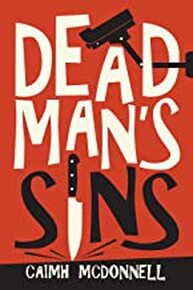 It is fair to say that I am a fan of the work of Caimh (pronounced Keeve) McDonnell. I have never made a secret of it. I won’t rest easy until his books are being read by the whole of the British and Irish reading public and a fair few other nationalities in the English speaking world (apologies to the Irish who speak Gaelic as their first language). It therefore gives me great pleasure to review “Dead Man’s Sins” and award it five stars. It isn’t the plot that makes this book so enjoyable. It is OK, it gets the job done and all that. No, it’s the dialogue.  In places the dialogue is so authentic and humorous that you feel you are listening into a conversation in a Dublin pub. It is the personification of “the craic” and you can almost smell the Guinness fumes rolling off the page (or through the screen of your e-reader). I would give you a few extracts to demonstrate what I mean but, taken out of context, they would be meaningless. Believe me, I tried, but I had to delete them because they didn’t give me the delight they did when they were part of the book. So I guess you’ll just have to trust me. 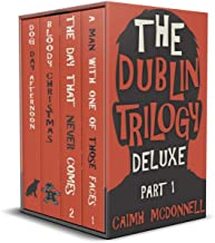 Caimh McDonnell started off writing “The Dublin Trilogy” a few years ago and the series now contains so many books that the word “trilogy” has been rather bent out of shape. There is also a spin off series set in New York, but I won’t go into that here, even though it does feature the main character from this book, which is set before he departs for the Big Apple. “Dead Man’s Sins” is book 5 of The Dublin Trilogy and is also a sequel to “Angels in the Moonlight”, which is book 3, but is set several years before books 1 and 2. And “Dead Man’s Sins” came out after Book 4, which is set after Book 2. Look, if you managed to deal with Star Wars episodes 1 to 3 being screened after episodes 4 to 6 but before episodes 7 to 9, you’ll get past this, OK!  The author - Caimh McDonnell The author - Caimh McDonnell Don’t worry if you haven’t read the earlier books. The plot of this one stands up well enough on its own and you’ll get the essence of the main character quite quickly. Which brings me to the protagonist for the book, Detective Bernard ‘Bunny’ McGarry, pride of the Garda Siochana. That’s the police, fuzz or cops to anyone born outside of Ireland. Bunny’s policing style is unconventional, to say the least but he gets results and that’s what counts. The story opens with Bunny unwillingly taking a sabbatical from the police. He receives what amounts to a distress call from the elderly mother of his dead partner (in the “colleague” sense of that word) ‘Gringo’ Spain. The elderly Mrs Spain is about to be evicted from her home by a rather nasty Dublin loan shark and, out of a sense of duty towards his dead partner, Bunny feels obliged to intervene. Bunny goes to see the loan shark, Coop Hannity, argues with him, threatens him, steals a garden gnome and departs. Unfortunately, the whole incident is captured on Hannity’s CCTV security system, the quality of which would make MI5 jealous. Why unfortunately? Because the next night Hannity gets stabbed to death. But it is the dialogue that made this book for me. So now Bunny must find out who killed Hannity or risk becoming ‘prime suspect’ himself. To help matters along, the detective assigned to lead the murder hunt is an old adversary of Bunny’s, who would love nothing more than to bang his old enemy up for the crime. From there the plot ticks along nicely, with enough incident to keep the pages turning. It is fair to say that this book is on the lighter end of the crime novel spectrum, as are all the Dublin Trilogy books, so if you want something heavier, stick with Ruth Rendell and Ian Rankin. But it is the dialogue that made this book for me. In parts it is so sublime it is a thing of beauty in itself. It provides most of the humour and all of the charm. I have been saying for years that these books would make a great TV series and it is dialogue like that which would come across so well on screen. I highly recommend “Dead Man’s Sins” I have only one flaw to comment on. The author leaves a loose end unresolved, which was a bit frustrating. It isn’t related to the central plot, but it left me asking “why didn’t he tell us who did…well whatever it was that they did ... and why?” There was a particular point made during the incident which suggested deeper skulduggery but was left unexplained. However, it wasn’t a big enough deal for me to downgrade my 5 star rating for this book. For fans of Irish humour, Irish crime drama or for readers who want to try something new and very entertaining, I highly recommend “Dead Man’s Sins” by Caimh McDonnell. To find out more about the book, just click on the cover image at the top of this blog. And if you would like to become a guest reviewer for the Selfishgenie blog, just go to the contacts page to communicate with us. There are just three rules:
If you have enjoyed this blog, found it entertaining or informative (or all three) then be sure not to miss future editions by signing up for our newsletter. Just click the button below.
0 Comments
 Authors have a bit of a love-hate relationship with reviews. We all want them, because we know that reviews help to sell our books. But we don’t want the bad reviews, because they have the opposite effect, or so we believe. But the one thing an author can’t predict, is how any reader will view their work. No matter how good your book is, there is almost certainly going to be someone who doesn’t like it. Regular readers of this blog will recall the one where we noted Oscar Wilde’s less-than-charitable views on Dickens’ book “The Old Curiosity Shop” and Dickens was considered to be a giant of the Victorian literary world. 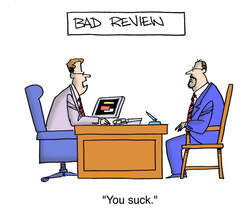 That’s the problem with reviews, we have no control over them. But a bad review can serve a purpose for an author. If we can identify what the reader didn’t like about our book, we can make sure we don’t do the same thing next time. After all, the definition of insanity is doing the same thing over and over and expecting a different result, so bad reviews provide learning opportunities. And if you are the sort of author that thinks they have nothing to learn from readers, you are probably doomed to get bad reviews forever. As a reader I do take a look at reviews, but I don’t actually read that many of them. You may think that is a bit odd, to look at them but not read them, but there is method in my madness. I mainly look at the split between the good reviews and the bad ones. If there are more good reviews than bad, then I’ll probably give the book a chance. 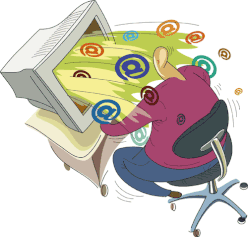 I do sometimes look at the bad reviews, to find out why the readers didn’t like the book. But I am very selective about the ones to which I pay attention. If a bad review is well written, in good English and provides valid reasons for why the reader didn’t like the book, then I’ll take it seriously. But if the bad review is just a short sentence which is mainly abuse, or if it’s written in a style that's the internet equivalent of a blunt crayon, then I don't take it seriously. I started using this method a few years ago, after reading hotel reviews on TripAdvisor. If someone has given a hotel a bad review, when everyone else seemed to be fine with it, then there has to be a valid reason (or so I thought). 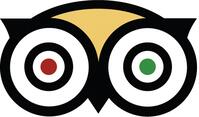 I’ll give you an example. We were going to visit Crete and wanted a nice hotel, but at a budget price. I found one that seemed to fit the bill and started reading the reviews. Most people were very positive about the hotel, but there were a few one-star reviews, which worried me a little. So I looked at one of them. The author of the review complained bitterly about a road running between the hotel and the beach. Apparently, the hotel’s website hadn’t mentioned it and he thought that he should have been told about it, as the hotel was listed as “beachfront”.  Well, we booked that hotel anyway, because both the location and price were right. And the road? Well, we expected to find a six-lane superhighway with cars whizzing up and down all day and all night at 100 mph. What we found was a very narrow road used to service the beachfront hotels and the number of vehicles using it each hour could probably be counted using the fingers of one hand. And they were being driven with caution. It took three paces to cross it (I counted them) and there we were, on the beach. So how was the hotel otherwise? It was OK. Actually, it was more than OK. We had a very nice week, ate some good food (OK, it wasn’t Michelin star standard, but it was tasty and plentiful) and drank some nice wine and all within our budget. We were happy to post a 4-star review after we got home. And that’s why reviews have to be treated with caution, especially the bad ones. People get upset about the strangest things and they take it out on whoever is handy. In the case of TripAdvisor, it’s the poor hotel owners who bear the brunt and in the case of books it’s the author of the book they just read. 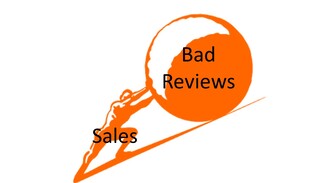 So, if you are an author and you get the odd bad review, please remember that you can’t please everyone. And if you are a reader, please remember that if the majority of other readers thought a book was worth four or five stars, then it is probably worth giving it a go. And if you are a reader who is going to post a bad review, please make sure that the standard of English you use is at least as good as that of the author you are about to criticise. It also helps considerably to say why you didn’t like the book. You will have your reasons, and the whole purpose of the review system is to share those reasons with others. Is there a “good way” of writing a book review? Author Luisa Plaja offers this advice.  Write a couple of sentences telling the reader what the book is about. Keep it short and simple; this shouldn’t become a synopsis of the book. For those readers familiar with the term “elevator pitch”, think about it like that. Tell the readers what you liked about the book. Even the worst books have some redeeming features, so make sure you write about those. After all, the author deserves praise for giving you the things you enjoy.  Tell the readers what you didn’t like about the book. This is the justification for awarding anything below 5 stars for the review. Even if you still award 5 stars, there may be something that you didn’t like, even if it was only a minor flaw. Be quite specific about what you did and didn’t like. Was it a character? Was it something in the plot? Was it the author’s use of language? Focus on why you didn’t like whatever it was, because that is what people always want to know. Whatever it was, the author may benefit from your insights and they can then correct the issue in their next book – which means you get to read better books. Obviously, the balance between the lengths of the paragraphs describing what you liked and what you didn’t like should reflect how you felt about the book as a whole. If you liked the book, then the “good” paragraph will be far longer than the “bad” paragraph.  Summarise your review with your overall impressions. If you are mainly positive, then your summary should also be positive and vice versa. But don’t just repeat the previous paragraphs. Although Luisa Pelja doesn’t mention it, we think it is helpful to mention the genre of the book up front. After all, readers don’t want to waste their time reading a review of a book they are unlikely to buy because it isn’t in their preferred genre. Here at Selfishgenie, we also make our recommendations clear: yes, definitely read this book if you like this sort of thing, or no, steer well clear. Is there anything a reader shouldn’t put in a review. Luisa Pelja doesn’t offer any advice on that, so we will.  Don’t be abusive. First of all, the author didn’t set out to write a bad book so they shouldn’t be abused for trying their best. Secondly, your opinion of the book is just that: an opinion. It isn’t a fact. Abuse isn’t constructive – it’s destructive. There is no beauty in destruction. Finally, abuse tells the world more about the abuser than the abused. The book reviews we publish on our website mainly conform to the format described by Luisa Peljac, but we do go further. That is because our reviews are also blogs. They are intended to go further than just looking at the book; they also provide information about the author, what sort of people may enjoy the book and maybe a few homespun stories about how the reviewer stumbled across the book in the first place. But for reviews that are posted on Amazon, Goodreads etc we stick to the basic format described above. And finally, if you have enjoyed this blog, found it entertaining or informative (or maybe all of those), be sure not to miss the next edition by signing up for our newsletter. We promise not to spam you. Just click the button. Readers are reminded that all book reviews are the opinion of our guest reviewers and not necessarily those of Selfishgenie Publishing. 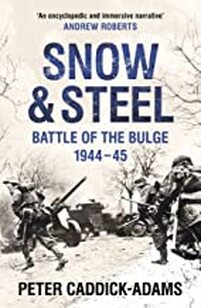 Like many of my generation, I learned a lot of my World War II history not in the classroom or from non-fiction books, but in the cinema. I now realise that was a great mistake, because those films were made for entertainment and are therefore over-simplified. They are also often embellished, which is worse because the true stories are usually dramatic enough not to require embellishment. Take “The Battle Of The Bulge” for example. While the film is based around factual events and does feature some of them in its plot, such as Nazis dressing in US Army uniforms as a deception, it then descends into an over-simplified race to gain access to Allied fuel stocks to keep the German tanks on the road. Even the scenery isn’t authentic as the tank battles are filmed on flat ground in a less than chilly Spain, so the snow that is present in the early part of the film is missing in many later scenes (something I didn’t pick up on in my youth). While that is one feature of the battle – the Germans were very short of fuel – it isn’t the main reason why the battle was lost. And it certainly wasn’t the reason the battle was fought in the first place. 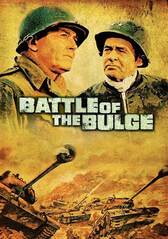 The film's poster, featuring Robert Ryan (right) as Lt Gen Grey and Henry Fonda as Lt Col Dan Kiley. The film's poster, featuring Robert Ryan (right) as Lt Gen Grey and Henry Fonda as Lt Col Dan Kiley. The film also forgets some of the main features of the battle, which were the intense cold, the appalling condition of the roads and the incredibly challenging terrain over which the battle was fought: thick pine forest, steep hills and criss-crossed by rivers with vulnerable bridges. All of that contributed to the loss of the battle. The modern road network disguises the fact that many of the roads in 1944 were little more than muddy tracks, which tank tracks churned into a freezing swamp. But the main reason for the Germans losing the battle, in my humble opinion, was the incredible heroism shown by the American soldiers involved and the flexibility of the Allied commanders in directing forces to the places where they could best fight the enemy. While the film displays this in cameo with the resistance of the 101st Airborne Division at Bastogne, it is only a tiny fraction of the story. 20 men were awarded the Congressional Medal of Honour for the battle, compared to the 16 that were awarded for D-Day. Only 473 were awarded for the entire Second World War.  Soldiers of the 82nd Airborne Division outside Bastogne. Soldiers of the 82nd Airborne Division outside Bastogne. One of the things the film doesn’t show, for example, was that the 101st Airborne had to be transported over 100 miles to Bastogne standing up in the back of trucks with no protection from the freezing weather. They then had to start fighting as soon as they arrived. They weren’t the only troops to undergo such an ordeal, I use them only for the purposes of illustration. Many soldiers had been on leave in Luxembourg city or Paris and ended up fighting while still wearing their dress uniforms. Several of the Allied commanders were also on leave or absent from their posts for other reasons. So thin were the Allied defences in places that the cooks, clerks and mechanics found themselves fighting in the front line.  The author, Peter Caddick-Adams Phd The author, Peter Caddick-Adams Phd Which brings me to the book, “Snow And Steel” by Peter Caddick-Adams. My current series of novels is set during World War II and part of one of my plots makes reference to the Battle of the Bulge, which took place from mid-December 1944 to mid-January 1945. The plot doesn’t involve the battle directly, but as it is mentioned I thought I had better make sure I understood the context so that I could better write the plot for my own book. I follow the author, Peter Caddick-Adams, on Twitter because we share a common interest in military history and World War II in particular. I had seen the occasional “plug” for this book, which was his latest work, so I thought “Why not? I need to know more about the battle, he’s written a book about the battle, so let’s give it a go.” Firstly, a little bit about the author. He holds an Honours degree in wars studies, attended the Royal Military Academy, Sandhurst, served as a soldier in the Balkans, Iraq and Afghanistan and now lectures in Military and Security Studies at the British Defence Academy, as well as writing books about Second World War battles. So, we can safely say he knows what he’s talking about, which is a good start. 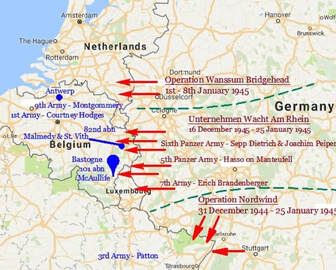 The battleground 1944 The battleground 1944 The most important part of understanding any battle is understanding the reason it is being fought. Why fight there? What did the attackers hope to achieve? Without understanding what the battle was about, you can’t know if it was a success or a failure. Yes, one side won and the other side lost, but did the winners achieve their goals? What were the consequences of losing? Was the sacrifice worth what it achieved? That is why the film of the Battle of the Bulge is so disappointing in historic terms, because it wasn’t about grabbing fuel for tanks, it was about turning the war around and pushing the Allies back to the sea, just as the Germans had in 1940. And that is where this book starts. Why was the battle being fought?  The Germans were using the same basic plan as had been used in 1914, which was the Schlieffen-Moltke plan, named after its Prussian creators when they devised it at the end of the 19th century. The plan involved a major offensive through the Ardennes Forest in Belgium and Luxembourg to strike into France where its defences were weakest. In 1914 it almost worked and in 1940 the same basic plan was used again and this time, using a combination of modern weaponry and speed, it did work. In December 1944 the aim was to strike through Luxembourg and Belgium to Antwerp, re-capture the strategically important port while, at the same time, splitting the British from their American allies so that the two forces could be defeated independently. Had the plan worked it might not have ended the war in Europe, giving the Germans a victory, but it would certainly have delayed the end of the war by many more months, possibly even years. And, of course, with the Allies defeated or delayed in the west it would allow Hitler to concentrate his forces once again to defeat Russia in the east.  German Panther V tanks advance through a Belgian village. German Panther V tanks advance through a Belgian village. The author then takes us into the minds of the commanders on the two sides. What they thought of the plan, what their mental state was in general after 5 years of war and what the political background was like. That was particularly important on the German side because by that time Hitler was directing the war almost single handed, ignoring or not seeking the advice of his military commanders. It was also important on the Allied side, where the Allied commander, General Eisenhower, was able to operate free of political interference. We then take a look at the military preparedness of both sides in the weeks and days preceding the battle. In order to assemble enough troops for the attack, the Germans had to strip both the Luftwaffe and the Kriegsmarine of men and draft into the army teenage boys, middle-aged men and some former soldiers who had already been discharged because of wounds sustained in earlier battles. It might be thought that these make-shift troops would prove to be a weak link in the plan, but they were surprisingly effective in the early days of the battle.  American troops take cover during a German attack American troops take cover during a German attack As well as the Volksgrenadiers (people’s grenadiers, the name given by Heinrich Himmler, who was responsible for their recruitment) there were the more seasoned troops of the German army and the SS and they provided all of the tank units that were used, as well as most of the artillery. The author provides a lot of detail about these men, having interviewed several of them. He provides similar amounts of detail for the Allied troops. On the other side, the Allies weren't prepared for a winter war. After the euphoria of D-Day and the liberation of France, the war was supposed to be over by Christmas. The Allies weren't equipped for one of the worst winters on record. Many of the casualties suffered weren't the result of combat, they were the result of the weather: hypothermia, frost bite and trench foot. Many American soldiers just froze to death. Once the battle starts the author takes us through what happened on the various axes of the German advance, telling us about the men who fought and the terrain over which the battle was conducted. He has visited a lot of it and provides some interesting details of what he has found while walking over the ground. His military eye is able to pick out details that a civilian would probably not notice. Readers who have a mind to do so, could pick up some interesting souvenirs should they ever visit the area.  An American Sherman tank at Bastogne. An American Sherman tank at Bastogne. Admittedly this is a bit of a niche subject and won’t be of much interest to some readers. It was also an American battle for the most part, so may not be of much interest to British readers, though there was some British involvement; General Montgomery was given command of the American forces at the northern end of the battlefield, and British troops did fight in some engagements. But the book is aimed at people with an interest in military history and World War II in particular. For those readers I thoroughly recommend “Snow and Steel” by Peter Caddick-Adams. To find out more about the book, click on the cover image at the top of this review. If you have found this blog interesting or informative, why not sign up for our newsletter to get more book recommendations. Just click the button below. Would you like to be a guest reviewer for the Selfishgenie Publishing blog? Contact us with details of the book you'd like to review. Just three rules:
The book reviews published here are the opinions of the reviewers and not necessarily those of Selfishgenie Publishing. 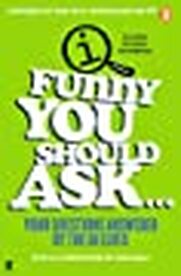 I came across this book, "Funny You Should Ask", by a rather unusual route, because it came out of a radio programme. Perhaps I had better explain. When I’m driving my car to the golf course to play golf on a Wednesday morning, I listen to the Zoe Ball show on BBC Radio 2. On that day each week she has a ten-minute feature in which the QI Elves are asked questions by members of the public and the Elves try to answer them. Perhaps a bit more explanation for those who don’t know what QI is, or a QI Elf for that matter.  QI is a panel show on BBC 2 TV in which the panellists try to come up with interesting (and possibly humorous) answers to various questions on a wide range of topics. Many of the answers given by the panellists turn out to be incorrect because we have been so badly taught over the years, having been given simplistic answers to complex questions. Some of the answers are wrong because our understanding of the world (and science) has advanced so much since we went to school (which was a very long time ago in my case). Panellists score points if they can come up with the “interesting” (ie correct) answers rather than the obvious and usually incorrect ones. Comedian Alan Davis is the only permanent member of the panel and he usually has the highest negative score (points are deducted for the wrong answers). His main role on the show is to play the fool, which he does quite convincingly. 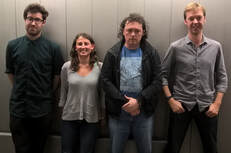 Some of the QI Elves Some of the QI Elves Anyway, the people on the programme who set the questions and research the answers are referred to as the QI Elves and on Wednesday mornings some of them can be heard answering questions on Radio 2. From those questions has come this book, featuring the best of the questions and their answers. It isn’t the first book to emerge from the TV show format, there are at least 7 Others based on the TV show alone. But I haven’t read those and I have read this. A lot of the questions have been asked by children, but that is a good thing, because children ask some of the best and most challenging questions, as any parent can tell you.  I’m not going to go into detail on a whole load of questions, but here are a few examples:
Now, finding out the answers to most of the questions isn’t going to change your life very much, but a lot of the answers did make me say “Wow, I never knew that.” And, at my age, there’s not a lot of things that can make me say that. At the very least it will give you some subjects on which to amaze/bore your friends with now that the pubs are open again and Covid-19 is starting to wear a bit thin as a conversation topic.  One of the great things about this book is that you don’t have to read it from cover to cover. It’s great to dip into when you take a fancy to it. The answers are also quite short, so it’s a great book for reading if you are liable to be interrupted from time to time – such as during the daily commute (or by your children asking awkward questions). Because so many of the questions have been asked by children, the answers have to be presented in language that children can understand – which is also great for adults. There isn’t a huge amount of jargon used and where it is used, it is explained. That makes the book very readable. If you want the full scientific answers, then I’m sure you have the necessary knowledge on how to do the research. Why only 4 stars? Well, let’s face it, it’s hardly War And Peace. It is interesting and entertaining though. I am happy to recommend “Funny You Should Ask” to all lovers of trivia and for those, like me, who went to school so long ago that we were taught the world was round, when its actually an oblate spheroid. And if you really want to know where baby kangaroos go to the toilet – this book is definitely for you. To find out more about the book, click on the cover image 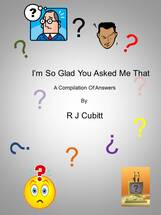 But the QI Elves aren’t the only people who answer questions. One of our authors does it too. Yes, he’s written three books (with a fourth in the pipeline) that answer the questions that you never knew you wanted to ask. His are aimed at more of an adult audience, but that doesn’t make them any less readable or informative. So, If you want to find out more about this series of books, titled “I’m So Glad You Asked Me That”, then go to the “Books” tab of this website and scroll down to the non-fiction works. If you have enjoyed this blog or found it helpful, make sure you don't miss an issue by signing up for our newsletter. Just click on the button below. We promise not to spam you and you can unsubscribe at any time. Would you like to be a guest reviewer for the Selfishgenie Publishing blog? Contact us with details of the book you'd like to review. Just three rules:
A Comedy Of Horror 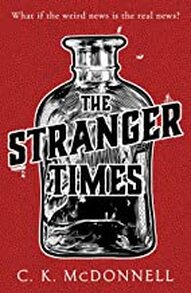 I have been a fan of Caimh (pronounced Keeve) McDonnell’s books since I first stumbled across one about three years ago, so this one took me a little bit by surprise. In a good way, I hasten to add. His earlier works were comedy crime capers set in Dublin, with one of the main characters then relocating to New York, to establish a new ensemble of characters. ‘The Stranger Times’ is a comedy Gothic horror caper, if you can imagine such a thing. If you can’t imagine that, don’t worry, because Caimh McDonnell can. The use of the definite article in the title isn’t a misprint on my part (or Caimh's), because The Stranger Times is a newspaper.  Well, more of a communications channel for the sad, the bad and the mad really, as most of the stuff they publish is hardly “news” unless you are of the tin foil hat persuasion or you believe you are the reincarnation of Cleopatra. That is until Hannah arrives on the scene. Not that she is the cause of the horror, far from it. But the horror story starts when she arrives, coincidentally. Up until now Caimh has set his books either in Dublin or New York (with an excursion to an unnamed American desert location for one title). For this book, however, he has relocated to Manchester. Perhaps that city had more of an air of Gothic Horror about it than Dublin or New York, or maybe Caimh had just visited the city. Who knows? The story is set around two sets of mythical people, the “Founders” and the “Folk”. I can’t tell you any more than that without giving away too much of the plot. Let me just say that one of those two groups are the good guys and the other are the bad guys, with humanity stuck in the middle and paying the price.  But, to cause confusion, you could be married to a member of the Founders or the Folk and not even know it. Hannah is what might be called a ‘trophy wife’ who lived in the lap of luxury until she could put up with her husband’s infidelity no longer, at which point she set fire to his house (accidentally, according to her). Now in need of money to live on, Hannah has to get a job and lacking any discernible skill set, the only place that will take her on is The Stranger Times. This introduces us to the lunatic Editor, Vincent Banecroft and the collection of misfits he has for staff. The only apparently sane person working for the newspaper (until Hannah’s arrival) is Grace, the office manager and even she has her quirks.  Two unexplained deaths, one written off as a suicide, gives Banecroft the sniff of a story and his team then set out to track it down. The rest of the book tells us how they go about it and what happens to them when they get on the wrong side of the wrong person (or maybe entity is a better word). As with all of Caimh’s books that I have read, this one is an entertaining, if undemanding, read. It moves along at a nice pace, the language is user friendly, the characters interesting and the plot is believable, if you are the sort of person who is a fan of the horror genre in the first place. This all makes the book ideal poolside fare if you are planning a holiday this year (You should be so lucky). In terms of the horror content, it isn’t going to keep you awake at night and in terms the comedy content it is probably best to call it amusing rather than rib tickling, which is why I have given it 4 stars rather than 5. But, for a light summer’s read, I recommend “The Stranger Times” by Caimh McDonnell and if you would like to find out more about it, just click on the cover image at the top of the blog. If you have enjoyed this blog and would like to be alerted when the next one is posted, just sign up to our newsletter, which will also keep you abreast of our new titles and our free offers. Spoiler alert, next week's blog is going to be a fiendishly difficult literary quiz. Would you like to be a guest reviewer for the Selfishgenie Publishing blog? Contact us with details of the book you'd like to review. Just three rules:
All book reviews posted on the Selfishgenie Publishing blog page are the opinions of the reviewers, not those of the Selfishgenie management. Help! My Tech Is Killing Me 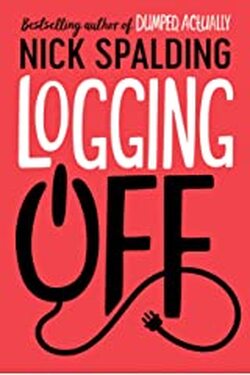 I am something of a fan of Nick Spalding’s books. They are easy to read and easy to put down if you have to do something else. I don’t think that anyone will ever accuse Nick of writing great literature, but that doesn’t mean that his books aren’t enjoyable. In fact, it’s because they are enjoyable that I read them. Nick Spalding uses everyday life as his inspiration. His plots are centred on things that the reader can relate to and may have experienced. Not all of them, of course. I’ve never renovated a ramshackle old farmhouse, which was the subject of “Bricking It”, but that didn’t stop me from enjoying it. “Logging Off” takes a look at the way some people use the internet, to the point where it becomes detrimental to their health and mental wellbeing.  Andy Bellows is a graphic designer who is somewhat internet obsessed. He has an app for everything, including going to the toilet. I don’t know if such an app exists, perhaps someone might like to tell me if it does. Not that I would ever use it. Anyway, Andy’s obsession with his apps is causing him physical ill health and some of his physical symptoms are evidence of his poor mental health, induced by his internet behaviour. On the advice of his doctor, Andy decides to undergo a “digital detox”, which requires him to give up all internet usage except for that essential to his work: no social media, no on-line shopping, no recording of his sleep patterns or his bowel movements and definitely no Googling of his medical symptoms. He can’t even use his apps to check the TV schedules.  He packs his iPad, his games console and his phone into a box and hides it away. Why he should give up his phone I found a bit puzzling. A phone is an essential tool and all Andy really had to do in order to conduct his detox was uninstall his apps. But at the same time, not having a phone becomes a plot point later on in the book, so even if it wasn’t necessary from a practical point of view, it was for the narrative. Andy’s best (and possibly only) friend Fergus, a local newspaper editor, decides that what Andy needs to do to make sure he sticks with his detox, is to announce it to the world – in Fergus’s newspaper, of course. This sets the scene for a lot of anxiety for Andy later on, but I don’t want to give away too much, so I won’t tell you how. But I can tell you that because of the newspaper article, for the first time in living memory Andy makes contact with a woman (two women actually) with romance in mind without the aid of digital match making. The outcome of at least one of those meetings is entirely predictable, so that isn’t a spoiler. The other is a little bit more bizarre, but I’ll let you find out how for yourself. Being a Nick Spalding book there are misadventures aplenty, many of which Andy blames on his lack of technology but which I would blame on Andy himself, but I won’t go into those. But I’ll never look at a duck the same way again. 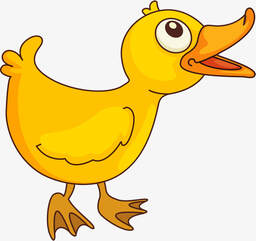 The book is evenly paced with regular highs and lows. It is amusing rather than funny but, like many of Nick Spalding’s books, it left me thinking about the content and what it might mean for me. Is that stiff neck I suffer due to the amount of time I spend ‘on-line’ each day? Maybe it is. Maybe I need to think about doing a digital detox. Or maybe it’s just the power of suggestion. Why only 4 stars? Really its because it isn’t absolutely the best book I’ve read so far this year. It isn’t even the best Nick Spalding book I’ve read this year. But it is enjoyable and I do recommend it. If you manage to get a holiday this year, it is the ideal fare for reading beside the swimming pool. I would recommend reading it on your phone or iPad, just so you can enjoy the irony. To find out more about “Logging Off” by Nick Spalding, just click the cover image at the top of the page. If you want to read more book reviews like this, just click the button below to sign up to receive the Selfishgenie Publishing newsletter. We promise not to bombard you with spam. All book reviews posted on the Selfishgenie Publishing blog page are the opinions of the reviewers, not those of the Selfishgenie management. The Secret Of My Success Is ...... Reading This Book 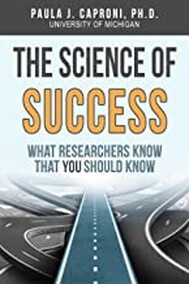 I’m not a great one for “self-improvement” books. Firstly, the only thing they really seem to improve is the author’s bank balance and, secondly, if they have changed someone’s life then there is a strong contextual element behind that change which means it's unique to that person. If the context is unique to an individual then what is advocated may not work for anyone else, so why buy a self-improvement book if it’s not going to work for me? However, “The Science of Success: What Researchers Know That You Should Know”, by Paula J Caproni Ph.D is different. Just to establish Dr Caproni’s credentials, she is a Professor of Business Studies in the Management and Organizations Department at the Ross School of Business at the University of Michigan. In academic terms, she is no lightweight because the University of Michigan is in the top 2% of universities in the world. What is different about this book is that it is based on decades of research by psychologists into how successful people behave that makes them more successful than others. It identifies the behaviours they have in common, which means that they aren’t unique or constrained by a particular set of circumstances. What is even more important is that these behaviours can, by and large, be learnt and applied by anyone. OK, if I don’t normally read books like this, how come I stumbled across it? You can blame Covid-19 for that. Because of the restrictions on movement placed on us by our government’s attempts to deal with the pandemic, I was filling some of my time doing a lot of on-line learning. Having just finished one short course I was looking for my next and I stumbled across this course, which bears the same title as the book. I signed up for the course and studied week one, at the end of which I was informed that there was some optional reading and it was this book. It wasn’t expensive (£3.78 on Kindle) so I bought it. "these behaviours can, by and large, be learnt "  As it turns out, if I’d just read the book I didn’t need to do the course as well, because the course is really just Dr Caproni telling the student the same stuff as is in the book. But I didn’t know that until I signed up for the course and what I start I try to finish. Which, it turns out, is an important behaviour when it comes to success. In reading the book I realised that I already did some of the things discussed – life-long learning is another one of the behaviours of the successful and my Covid inspired learning is part of that. That probably accounts, in part, for some of the success I have had in my life. I also realised that I had, at times, sabotaged my own endeavours by behaving in ways that got in the way of achieving success. Looking back over my life that also accounted for a lot. But this is a book review, not a confessional, so I won’t go into that. A common phrase often heard these days is “Change one thing!”. The good news is that, using this book, you can change one thing and see how it works out. You don’t have to swallow the whole book, you can make changes incrementally and see how they affect your life before you change something else. "Which, it turns out, is an important behaviour when it comes to success." 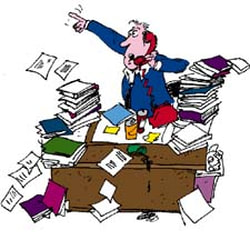 Besides, if you try to change everything at the same time you will probably overload yourself and that is going to hinder more than it will help. If that sounds like a long road to travel, you are right. It turns out that the ability to delay gratification (a dying personality trait in this world of instant gratification) is another behaviour that promotes success. So, if you don’t want to take the long road, you may be doomed to be less than successful. But the good news is that we are also encouraged to give something up, or modify the way we do it, in order to make time for us to do the new things we want to do. For example, if you decide you want to take more exercise, you might need to sacrifice some of your reading time in order to accommodate it. But that doesn’t mean giving up books, because you can listen to an audio book while exercising. Time management of that sort features quite heavily in some sections of the book. The very first thing Dr Caproni advises is to identify what success actually means for you (or, in this case, me). It may mean becoming a multi-billionaire, but it doesn’t have to. However you define success it has to be what you want and what you value, not what someone wants for you (or from you). So, some people will define it as being a multi-billionaire, but others may just define it as having a more satisfying job, being a valued member of a team, getting a promotion at work or having a happy family life. It doesn’t matter how anyone else measures success, it is how you measure it that’s important. "It doesn’t matter how anyone else measures success, it is how you measure it that’s important." In six chapters Dr Caproni takes us through the research into four different areas of behaviour that mark out successful people and how we, the reader, can learn those behaviours for ourselves and apply them in our lives.  Yes, there is a practical element to this. Reading about the research won’t change a thing for anyone. Only by making changes to our lives will we become more successful. To use a phrase I learned many years ago “If you always do what you always did, you’ll always get what you always got!” (Henry Ford) Or, to misquote Albert Einstein (who probably didn’t say it anyway) “Insanity is doing the same thing over and over and expecting a different outcome each time.” Within the book Ch 1 is a general introduction; Ch 2 deals with mindsets and how focusing only on results can constrain our lives; Ch 3 is about being or becoming an expert; Ch 4 focuses on motivation (yes, you do have to be motivated); Ch 5 is about the importance of relationships and Ch 6 is about creating an action plan to move yourself in the direction you wish to travel. “If you always do what you always did, you’ll always get what you always got!” (Henry Ford) Dr Caproni draws on real world examples of people who have made great strides in being successful. Some of the names will be familiar, some less so and at least one, a Chinese child, you will probably never have heard of. But each example used, demonstrates a different aspect of the behaviours that Dr Caproni is teaching. No promises are made of overnight success or achieving great wealth. It isn’t that sort of book. But within its pages are things that everyone (and I do mean everyone) can learn that will make them more successful and, importantly, happier people.  Because happiness and success usually go hand in hand; or so Dr Caproni tells us. Before you say that there are many successful people that aren’t happy, I have to both agree with you and disagree with you. Because you don’t know how those people measure success. They may never be happy because they define success as being the richest, the prettiest, the greatest (whatever) or something else. Which means they will never be happy if they aren’t that thing. Because there can only ever be one of those things with “est” at the end of the word. There can only be one richest person, one greatest athlete, one best actor etc and if that is your goal then you aren’t going to be happy if you fail to achieve it. But for those whose success is measured without being one of those things, then happiness is more likely. Again, Dr Caproni tells us why that should be and, generally, it has nothing to do with the size of your bank balance or being numero uno in whatever field you are in. "Because happiness and success usually go hand in hand" Considering that this book is based on psychological research, it is very easy to read. Dr Caproni has chosen her language with the lay reader in mind. There isn’t much in the way of jargon but, occasionally, Dr Caproni does rather labour a point; however, that is a very minor criticism. And, if you don’t want to buy the book, you can still sign up for the course for free and learn the lessons that way. It is presented entirely as video sessions, which some people might prefer. I have no hesitation about recommending “The Science of Success: What Researchers Know That You Should Know”, by Paula J Caproni Ph.D, to anyone who wants to make more of their life. To find out more about the book, click on the book’s cover image at the beginning of this blog. To read more book reviews like this, sign up for our newsletter so you never miss one. Just click on the button below. This week’s blog features reviews of two books, neither of which are published by Selfishgenie Publishing. Both are by the same author, Rohini Sunderam. The reviews are submitted by one of our authors, Robert Cubitt. All book reviews posted on the Selfishgenie Publishing blog page are the opinions of the reviewers, not those of the Selfishgenie management. Rohini Sunderam was born in Halifax, Nova Scotia but now lives in Bahrain. She describes herself as a “semi-retired advertising copywriter”. She is very active in writing groups in Bahrain and was shortlisted for the Atlantis Short Story Contest in 2013. She was also longlisted for the WOW Women on Writing CNF Essay contest for Q4 2020. A Little Gem For The Romantics. 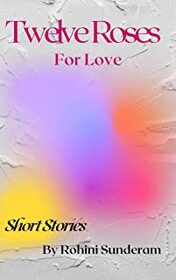 When it comes to the genres I read, I have to admit that romance and love stories aren’t the first shelf I go to in the library, but I do occasionally dip my toe into those waters and in the case of “12 Roses For Love”, by Rohini Sunderam, I’m glad I did. This collection of short stories is a real gem. Firstly, while their theme is love and romance, they are far from traditional in their approach. If I tell you that one of the stories has an armchair as its central character, you can probably understand what I’m getting at. The stories are set in different time periods and involve different characters (except for two of them), but they all have love at their core though, as already mentioned, the nature of that love is sometimes unconventional. "The stories are beautifully told" The stories are beautifully told, with great use of language. There is a kind of poetry behind them. The book isn’t long, only 61 pages, but that is long enough to tell the 12 short stories that gives the book its title. Why 4 stars rather than 5? I felt that one or two of the stories were a fraction short of being complete. They left unanswered questions which, on a personal level, I found frustrating. But that may be the author’s intention, to leave an air of mystery for the reader to enjoy and other readers might feel that the stories ended in just the right place. I certainly have no hesitation in recommending this to lovers of both romantic fiction and short stories. You can find out more about “12 Roses For Love” by Rohini Sunderam here. Must Read Poetry For The Corporate Masses  It was so lovely to finally find a book of poetry that didn’t make me groan with despair. There’s nothing wrong with poetry as an art form of course, but so much of it, particularly contemporary poetry, is just bad, bad, bad. But not Corpoetry by Rohini Sunderam. This is a delight. Perhaps it was the way I was taught poetry at school. Endless boring epics from poets that may, or may not, have been high on drugs. I can’t listen to a verse of the Rhyme Of The Ancient Mariner without suffering flashbacks of my own, and I assure you those aren’t drugs related. They are Samuel Taylor Coleridge related. When I was asked to review this book it didn’t fill me with joy, but I love a challenge and I thought it might be challenging to have to find something positive to say about yet more poetry, but I needn’t have worried. There’s plenty of positive things to say about this collection and I’m more than happy to say them. The theme of the collection is the Corporation. This means that there is something in this collection for most people. We have met the people Rohini writes about. We may even be the people she is writing about. In fact I’d place a bet that any reader will be able to pick themselves out in at least one of the poems. To quote from a poem entitled 'Alpha Me', who hasn’t heard something like this? “Modern and millennium smart Totally, utterly state of the art That’s me, Alpha me Perfectly, ideally Suited and Booted.” The poems are short, use nice simple metaphors and analogies, but get to the very heart of the subject like a scalpel cutting into flesh. There is a sharp wittiness coupled to just a tiny touch of cynicism behind Rohini’s writings. That air of worldly weariness, that ‘been there, done that, got the tee-shirt’ feeling. "I laughed out loud" I have to say that I laughed out loud at some of these poems, but some of them also made me stop and think about the way people are managed and treated in the corporate workplace. This isn’t a Pam Ayers world of fluffy but comedic bunny rabbits living in hutches, or regret at poor dental habits. This is sharp and satirical stuff. Even if you don’t work in the corporate world a lot of what you will read is about people and situations you will recognise from pretty much any place of employment. The following poem I reproduce in full, because it is so up to date and captures a mood. It’s called 'Big Cheeses'. Can someone please explain to me A small insignificant nonentity What is it that the top guys do To merit all that ballyhoo? Six and seven figure salaries Numbers like leaves on trees In stratospheres so rarefied To get there I am terrified. But, even so, I’d like to know What it is they do so Fantastically, uniquely great That plunged us into this state? If I screwed up my little job They would have me on the hop. My permanent part-time state Would be reduced to hourly rate. But when they screw up really big time Mega, giga, hugely big time, Enough to shut down whole departments (some poor mid-levels lost apartments). But those guys at the very top (it’s enough to make my heart stop) Would you believe that they With gazillions walked away? Were they fired? So I’m told. And if I may be so bold, You see I really need to understand I can’t grasp this notion and Quite get my head around it They lost our money, every bit, That we had all worked so hard to get. They made some really big mistakes Yet they received golden handshakes. I never thought I would ever write this about a book of poetry, but if you want to read something unique, original and amusing please give this book a try. I can’t imagine it being too long before we start seeing extracts of Rohini’s poems adorning mouse mats, mugs, calendars and posters. I’ll be the first into Rymans. You can find out more about “Corpoetry” by Rohini Sunderam here. Submitting books for review. Having read the above reviews, you may be considering submitting your own work for us to feature. You are welcome to do so, but we have to issue a word of warning.
First, our authors are very busy people who have very tall "to be read" piles. They will probably get to your book eventually, but the time taken to do so may exceed the radioactive half-life of Bismuth-209 (approximately 2.9 x 10 to the power 19 years). Secondly, our authors are very honest in their reviews. If they think your book is only worth 1 star (or even no stars) they will say so and they will provide reasons why. So, if you are not prepared to risk that, it is better not to send your book in. But look on the positive side - they will also award 5 stars if they think your book merits that. And it's only their opinion anyway. If you still want to submit a book for review, then please:
Summarised versions of reviews will also be posted on Amazon and Goodreads, and may also be posted on other sites by request. And if you would like to be notifed when our blogs are posted, you can sign up for our newsletter by clicking on the button. |
AuthorThis blog is compiled and curated by the Selfishgenie publishing team. Archives
March 2025
|



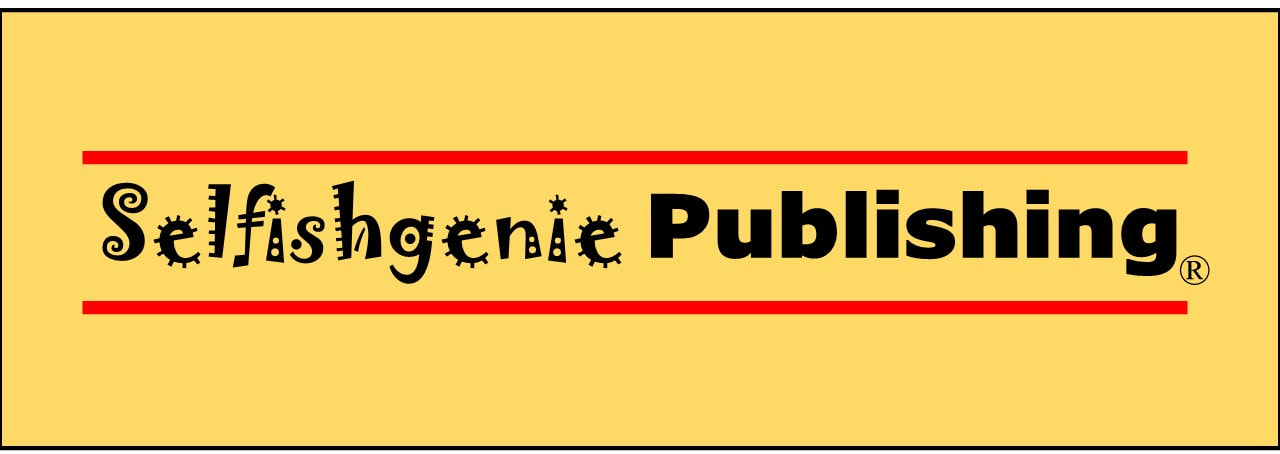





 RSS Feed
RSS Feed